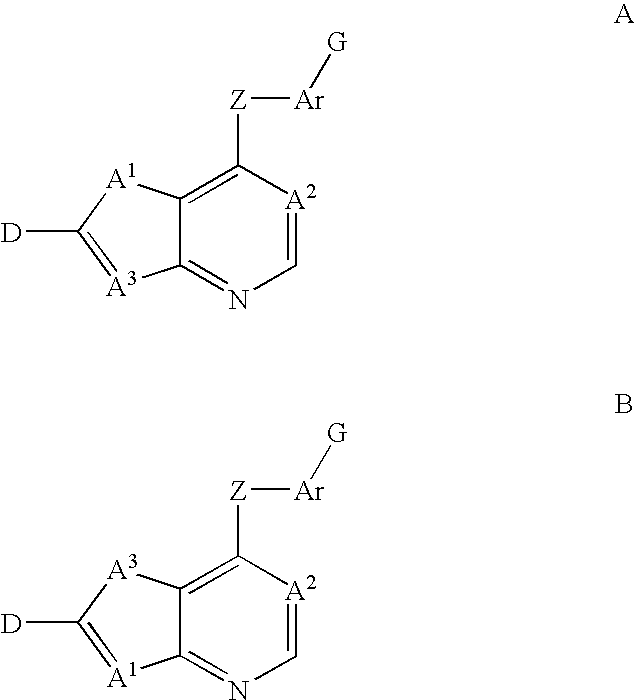Inhibitors of VEGF receptor and HGF receptor signaling
- Summary
- Abstract
- Description
- Claims
- Application Information
AI Technical Summary
Benefits of technology
Problems solved by technology
Method used
Image
Examples
example 2
N1-(3-Fluoro-4-(2-(1-methyl-]H-imidazol-2-yl)thieno[3,2-b]pyridin-7-yloxy)phenyl)-N3-phenylmalonamide (5b)
Step 1. 3-Oxo-3-(phenylamino)propanoic acid (1) (one-step procedure)
[0504] To a solution of aniline (13 mL, 143 mmol) in DCM (290 mL) was added TMSCl (18.2 mL, 143 mmol) at room temperature and the reaction mixture was stirred for 1 hour. [Rigo, B.; Fasseur, D.; Cauliez, P. and Couturier, D. Tetrahedron Lett.; 30; 23; 1989; 3073-3076.]. 2,2-Dimethyl-1,3-dioxane-4,6-dione (20.6 g, 143 mmol) was added and combined reaction mixture was stirred overnight at room temperature, poured into saturated NaHCO3 solution and extracted with EtOAc. The aqueous phase was collected, acidified with conc. HCl to pH-3 by addition of 2N HCl and extracted with DCM. The organic phase was dried over anhydrous Na2SO4, filtered and concentrated under reduced pressure affording 3-oxo-3-(phenylamino)propanoic acid (1, 16.82 g, 65% yield) as a white solid. MS (m / z): 180.0 (25%) (M+H), 202.0 (100%) (M+Na)....
example 3
N1-{3-Fluoro-4-[2-(1-methyl-1H-imidazol-4-yl)thieno[3,2-b]pyridin-7-yloxy]-phenyl}-N3-phenylmalonamide (5c)
Step 1: 7-Chloro-2-(1-methyl-1H-imidazol-4-yl)thieno[3,2-b]pyridine (10)
[0510] Following the procedure described for compound 7 (example 2, step 3) but substituting 2-bromo-1-methyl-]H-imidazole for 4-bromo-1-methyl-1H-imidazole [a) Begtrup, M.; Larsen, P.; Acta Chem. Scand. 44, 10; 1990; 1050-1057. b) Begtrup, M.; Bull. Soc. Chim. Belg.; 97; 8-9; 1988; 573-598. c) Begtrup, M.; Larsen, P.; Chem. Pharm. Bull. 42, 9; 1994; 1784-1790.], title compound 10 was obtained as an off-white solid (29% yield). MS (m / z): 250.1 (M+H).
Step 2: 7-(2-Fluoro-4-nitrophenoxy)-2-(1-methyl-1H-imidazol-4-yl)thieno[3,2-b]pyridine (11)
[0511] Following the procedure described for the nitro compound 8 (example 2, step 4) but substituting compound 7 for the compound 10, title compound 11 was obtained as a red solid (46% yield). MS (m / z): 371.1 (M+H).
Step 3: 3-Fluoro-4-(2-(1-methyl-1H-imidazol-4-yl)thi...
example 4
N1-(4-(2-(1-Ethyl-1H-imidazol-4-yl)thieno[3,2-b]pyridin-7-yloxy)-3-fluorophenyl)-N3-phenylmalonamide (5d)
Step 1: 7-Chloro-2-(1-ethyl-1-H-imidazol-4-yl)thieno[3,2-b]pyridine (13)
[0514] Following the procedure described for compound 7 (example 2, step 3) but substituting 2-bromo-1-methyl-JH-imidazole for 4-bromo-1-ethyl-1H-imodazole [a) Begtrup, M.: Larsen, P.; Acta Chem. Scand. 44, 10; 1990; 1050-1057. b) Begtrup, M.; Bull. Soc. Chim. Belg.; 97; 8-9; 1988; 573-598. c) Begtrup, M.; Larsen, P.; Chem. Pharm. Bull. 42, 9; 1994; 1784-1790.], title compound 13 was obtained as a yellow solid (30% yield). MS (m / z): 263.9 (M+H).
Step 2: 2-(1-Ethyl-1H-imidazol-4-yl)-7-(2-fluoro-4-nitrophenoxy)thieno[3,2-b]pyridine (14)
[0515] Following the procedure described for 8 (example 2, step 4) but substituting compound 7 for compound 10, title compound 14 was obtained as a yellow solid (76% yield). MS (m / z): 384.9 (M+H).
Step 3: 4-(2-(1-Ethyl-1H-imidazol-4-yl)thieno[3,2-b]pyridin-7-yloxy)-3-fluoroben...
PUM
| Property | Measurement | Unit |
|---|---|---|
| Volume | aaaaa | aaaaa |
| Volume | aaaaa | aaaaa |
| Volume | aaaaa | aaaaa |
Abstract
Description
Claims
Application Information
 Login to View More
Login to View More - R&D
- Intellectual Property
- Life Sciences
- Materials
- Tech Scout
- Unparalleled Data Quality
- Higher Quality Content
- 60% Fewer Hallucinations
Browse by: Latest US Patents, China's latest patents, Technical Efficacy Thesaurus, Application Domain, Technology Topic, Popular Technical Reports.
© 2025 PatSnap. All rights reserved.Legal|Privacy policy|Modern Slavery Act Transparency Statement|Sitemap|About US| Contact US: help@patsnap.com



